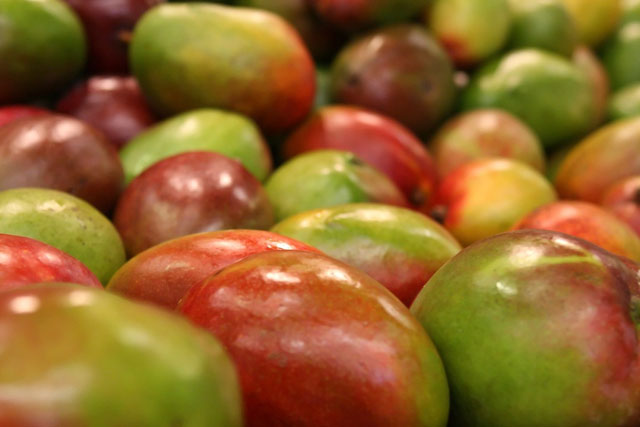Can Dogs Eat Mango? - Everything You Need to Know


Is Mango Safe for Dogs?
Many dog owners wonder if it is safe to feed their furry friends mango. The answer is yes, dogs can eat mango, but there are a few things to keep in mind. Mango is a tropical fruit that is not toxic to dogs, and it can provide some nutritional benefits. However, it is important to prepare and serve mango properly to ensure the safety and well-being of your dog.
Nutritional Benefits of Mango for Dogs
Mango is not only delicious but also packed with nutrients that can be beneficial for dogs. It is a good source of dietary fiber, which can help with digestion and promote a healthy gut. Mango is also rich in vitamins A, B6, C, and E, which are essential for a dog's overall health and immune system.
Vitamin A is important for maintaining healthy skin and coat, while vitamin C is an antioxidant that can help boost the immune system. Vitamin E is known for its antioxidant properties and can help protect cells from damage. Vitamin B6 is involved in various bodily functions, including metabolism and brain development.
Feeding Mango to Dogs in Moderation
While mango can be a healthy addition to a dog's diet, it should be fed in moderation. Like any fruit, mango contains natural sugars, which can cause weight gain and other health issues if consumed in excess. It is recommended to give mango as an occasional treat or as part of a balanced diet.
When feeding mango to your dog, it is important to consider their size and weight. Smaller dogs should be given smaller portions, while larger dogs can have slightly larger servings. It is always best to start with a small amount and monitor your dog's reaction before increasing the portion size.
Precautions When Feeding Mango to Dogs
While mango is generally safe for dogs, there are a few precautions to keep in mind. First, it is important to remove the skin of the mango before feeding it to your dog. The skin can be difficult for dogs to digest and may cause gastrointestinal upset or blockages.
Additionally, the pit of the mango should be removed as it can pose a choking hazard and may cause obstructions in the digestive tract. Mango pits also contain small amounts of cyanide, which can be harmful if ingested in large quantities.
Removing the Skin and Pit of Mango
To prepare mango for your dog, start by washing the fruit thoroughly to remove any dirt or pesticides. Next, use a sharp knife to carefully cut off both ends of the mango. Then, stand the mango upright on one of the cut ends and slice off the skin from top to bottom, following the curve of the fruit.
Once the skin is removed, you can cut the mango into small, bite-sized pieces for your dog. Remember to remove the pit by cutting around it and discarding it. It is important to ensure that there are no traces of the pit left in the mango pieces before feeding them to your dog.
Potential Risks of Mango Pits
While the flesh of the mango is safe for dogs to consume, the pit can be a potential hazard. Mango pits are large and hard, making them a choking risk for dogs, especially small breeds or those who tend to gulp their food without chewing properly.
In addition to the choking risk, mango pits can also cause obstructions in the digestive tract if swallowed. This can lead to serious health issues and may require surgical intervention to remove the pit. It is important to keep mango pits out of your dog's reach and to supervise them while they are eating mango to prevent any accidents.
Signs of Mango Pit Obstruction
If your dog accidentally swallows a mango pit, it is important to monitor them closely for any signs of obstruction. Symptoms of a mango pit obstruction may include vomiting, diarrhea, abdominal pain, loss of appetite, and lethargy.
If you notice any of these signs or if your dog's behavior changes after consuming a mango pit, it is crucial to contact your veterinarian immediately. They will be able to assess the situation and provide the necessary treatment to ensure your dog's well-being.
Overfeeding Mango to Dogs
While mango can be a healthy and tasty treat for dogs, it is important not to overfeed it. Giving your dog too much mango or any fruit or vegetable can lead to digestive upset, including bellyaches and diarrhea.
Remember that treats should only make up a small portion of your dog's overall diet. It is important to provide a balanced and nutritionally complete diet that meets all of your dog's dietary needs. If you have any concerns about incorporating mango or any other food into your dog's diet, it is always best to consult with your veterinarian.
Consulting a Veterinarian
Your veterinarian can also help you determine the appropriate portion size and frequency of mango treats for your dog. They may also be able to recommend other fruits or vegetables that are safe and beneficial for your furry friend.
In conclusion, dogs can eat mango, but it should be prepared and served properly. Mango can provide some nutritional benefits for dogs, but it should be fed in moderation. Remember to remove the skin and pit of the mango before feeding it to your dog, and always monitor them for any signs of discomfort or obstruction. If you have any concerns, it is best to consult with your veterinarian for guidance.


Related posts